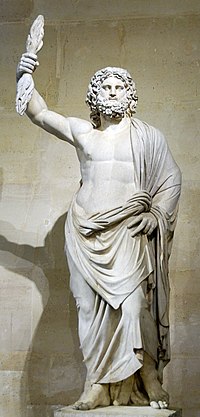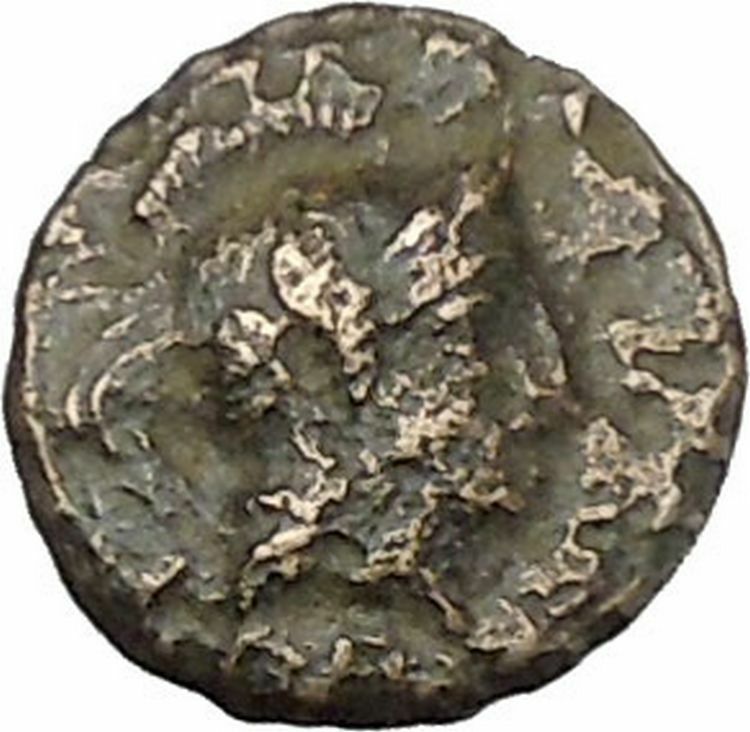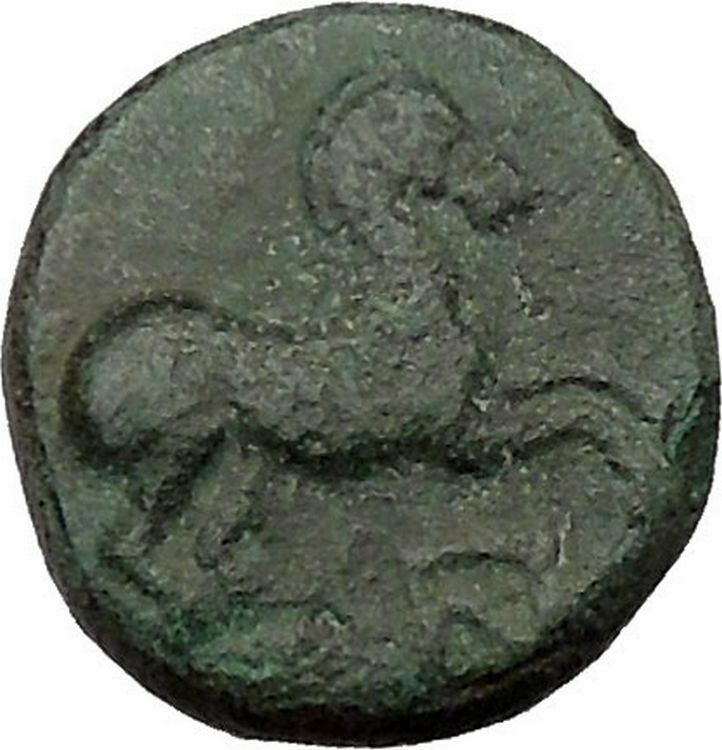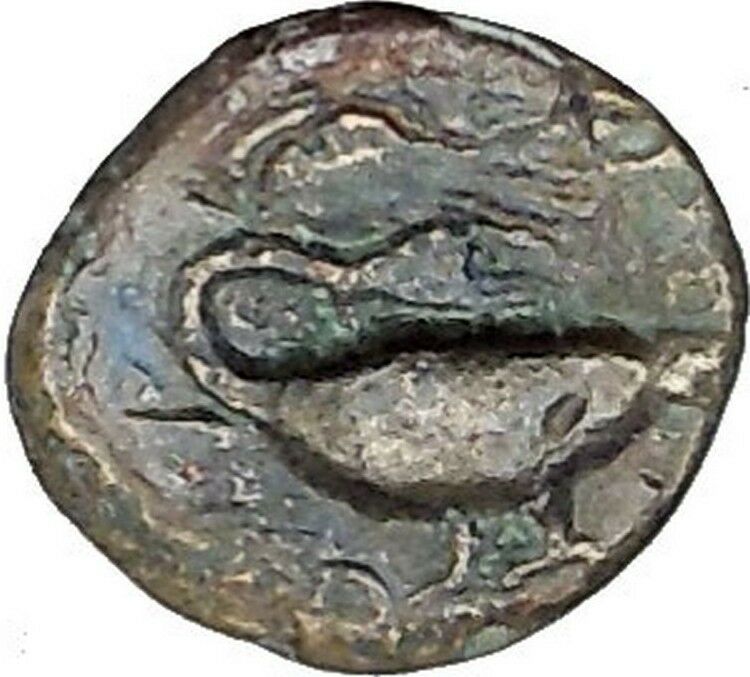|
Greek city of Gaza in Judaea
Bronze 17mm (3.50 grams) Struck circa 2nd-1st Century B.C.
Reference: Sear 6085
Laureate head of Zeus right.
ΔHMOV ΓAIAIΩN, Double cornucopaiae, springing from branch with two leaves.
You are bidding on the exact item pictured, provided with a Certificate of Authenticity and Lifetime Guarantee of Authenticity.
 In the ancient Greek religion, Zeus was the “Father of Gods and men” who ruled the Olympians of Mount Olympus as a father ruled the family. He was the god of sky and thunder in Greek mythology. His Roman counterpart is Jupiter and Etruscan counterpart is Tinia. In the ancient Greek religion, Zeus was the “Father of Gods and men” who ruled the Olympians of Mount Olympus as a father ruled the family. He was the god of sky and thunder in Greek mythology. His Roman counterpart is Jupiter and Etruscan counterpart is Tinia.
Zeus was the child of Cronus and Rhea, and the youngest of his siblings. In most traditions he was married to Hera, although, at the oracle of Dodona, his consort was Dione: according to the Iliad, he is the father of Aphrodite by Dione. He is known for his erotic escapades. These resulted in many godly and heroic offspring, including Athena, Apollo and Artemis, Hermes, Persephone (by Demeter), Dionysus, Perseus, Heracles, Helen of Troy, Minos, and the Muses (by Mnemosyne); by Hera, he is usually said to have fathered Ares, Hebe and Hephaestus.
As Walter Burkert points out in his book, Greek Religion, “Even the gods who are not his natural children address him as Father, and all the gods rise in his presence.” For the Greeks, he was the King of the Gods, who oversaw the universe. As Pausanias observed, “That Zeus is king in heaven is a saying common to all men”. In Hesiod’s Theogony Zeus assigns the various gods their roles. In the Homeric Hymns he is referred to as the chieftain of the gods.
His symbols are the thunderbolt, eagle, bull, and oak. In addition to his Indo-European inheritance, the classical “cloud-gatherer” also derives certain iconographic traits from the cultures of the Ancient Near East, such as the scepter. Zeus is frequently depicted by Greek artists in one of two poses: standing, striding forward, with a thunderbolt leveled in his raised right hand, or seated in majesty.
_-_Google_Art_Project.jpg/260px-Peter_Paul_Rubens_-_Abundance_(Abundantia)_-_Google_Art_Project.jpg) The cornucopia (from Latin cornu copiae) or horn of plenty is a symbol of abundance and nourishment, commonly a large horn-shaped container overflowing with produce, flowers or nuts. The horn originates from classical antiquity, it has continued as a symbol in Western art, and it is particularly associated with the Thanksgiving holiday in North America. The cornucopia (from Latin cornu copiae) or horn of plenty is a symbol of abundance and nourishment, commonly a large horn-shaped container overflowing with produce, flowers or nuts. The horn originates from classical antiquity, it has continued as a symbol in Western art, and it is particularly associated with the Thanksgiving holiday in North America.
Mythology offers multiple explanations of the origin of the cornucopia. One of the best-known involves the birth and nurturance of the infant Zeus, who had to be hidden from his devouring father Kronus. In a cave on Mount Ida on the island of Crete, baby Zeus was cared for and protected by a number of divine attendants, including the goat Amalthea (“Nourishing Goddess”), who fed him with her milk. The suckling future king of the gods had unusual abilities and strength, and in playing with his nursemaid accidentally broke off one of her horns, which then had the divine power to provide unending nourishment, as the foster mother had to the god.
In another myth, the cornucopia was created when Heracles (Roman Hercules) wrestled with the river god Achelous and wrenched off one of his horns; river gods were sometimes depicted as horned. This version is represented in the Achelous and Hercules mural painting by the American Regionalist artist Thomas Hart Benton.
The cornucopia became the attribute of several Greek and Roman deities, particularly those associated with the harvest, prosperity, or spiritual abundance, such as personifications of Earth (Gaia or Terra); the child Plutus, god of riches and son of the grain goddess Demeter; the nymph Maia; and Fortuna, the goddess of luck, who had the power to grant prosperity. In Roman Imperial cult, abstract Roman deities who fostered peace (pax Romana) and prosperity were also depicted with a cornucopia, including Abundantia, “Abundance” personified, and Annona, goddess of the grain supply to the city of Rome. Pluto, the classical ruler of the underworld in the mystery religions, was a giver of agricultural, mineral and spiritual wealth, and in art often holds a cornucopia to distinguish him from the gloomier Hades, who holds a drinking horn instead.
The known history of Gaza spans 4,000 years. Gaza was ruled, destroyed and repopulated by various dynasties, empires, and peoples. Originally a Canaanite settlement, it came under the control of the ancient Egyptians for roughly 350 years before being conquered and becoming one of the Philistines’ principal cities. Gaza fell to the Israelites in about 1000 BCE but became part of the Assyrian Empire around 730 BCE. Alexander the Great besieged and captured the city in 332 BCE. Most of the inhabitants were killed during the assault, and the city, which became a center for Hellenistic learning and philosophy, was resettled by nearby Bedouins. The area changed hands regularly between two Greek successor-kingdoms, the Seleucids of Syria and the Ptolemies of Egypt, until it was besieged and taken by the Hasmoneans in 96 BCE.
Gaza was rebuilt by Roman General Pompey Magnus, and granted to Herod the Great thirty years later. Throughout the Roman period, Gaza maintained its prosperity, receiving grants from several different emperors. A 500-member senate governed the city, which had a diverse population of Greeks, Romans, Jews, Egyptians, Persians and Nabateans. Conversion to Christianity in the city was spearheaded and completed under Saint Porphyrius, who destroyed its eight pagan temples between 396 and 420 CE. Gaza was conquered by the Muslim general Amr ibn al-‘As in 637 CE, and most Gazans adopted Islam during early Muslim rule. Thereafter, the city went through periods of prosperity and decline. The Crusaders wrested control of Gaza from the Fatimids in 1100, but were driven out by Saladin. Gaza was in Mamluk hands by the late 13th century, and became the capital of a province that stretched from the Sinai Peninsula to Caesarea. It witnessed a golden age under the Ottoman-appointed Ridwan dynasty in the 16th century.
Gaza experienced destructive earthquakes in 1903 and 1914. In 1917, during World War I, British forces captured the city. Gaza grew significantly in the first half of the 20th century under Mandatory rule. The population of the city swelled as a result of the Palestinian exodus during the 1948 Arab-Israeli War. Gaza came under Egyptian rule until it was occupied by Israel during the 1967 Six Day War. Gaza became a center of political resistance during the First Intifada, and under the Oslo Accords of 1993, it was assigned to be under the direct control of the newly established Palestinian Authority. Israel unilaterally withdrew from Gaza in 2005. By 2007, Hamas emerged both as the victor in Palestinian elections and in factional fighting with rival Fatah in the city and in the wider Gaza Strip and has since been the sole governing authority. Israel subsequently blockaded the Strip and launched assaults against it in 2008-2009, 2012 and 2014, as a response to rocket attacks.

Painting of Gaza by David Roberts, 1839
|




 In the ancient Greek religion, Zeus was the “Father of Gods and men” who ruled the Olympians of Mount Olympus as a father ruled the family. He was the god of sky and thunder in Greek mythology. His Roman counterpart is Jupiter and Etruscan counterpart is Tinia.
In the ancient Greek religion, Zeus was the “Father of Gods and men” who ruled the Olympians of Mount Olympus as a father ruled the family. He was the god of sky and thunder in Greek mythology. His Roman counterpart is Jupiter and Etruscan counterpart is Tinia._-_Google_Art_Project.jpg/260px-Peter_Paul_Rubens_-_Abundance_(Abundantia)_-_Google_Art_Project.jpg) The cornucopia (from Latin cornu copiae) or horn of plenty is a symbol of abundance and nourishment, commonly a large horn-shaped container overflowing with produce, flowers or nuts. The horn originates from classical antiquity, it has continued as a symbol in Western art, and it is particularly associated with the Thanksgiving holiday in North America.
The cornucopia (from Latin cornu copiae) or horn of plenty is a symbol of abundance and nourishment, commonly a large horn-shaped container overflowing with produce, flowers or nuts. The horn originates from classical antiquity, it has continued as a symbol in Western art, and it is particularly associated with the Thanksgiving holiday in North America.





